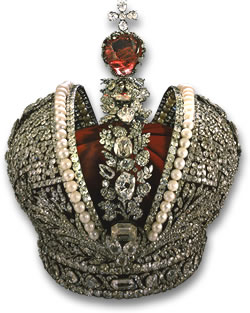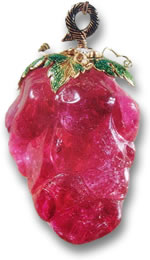Your Details
Your Details
|
Reviewed By Andreas Zabczyk
The Tsars and Their Jewels The Imperial Russian Crown - Diamonds, Pearls and Red Spinel
Before the Russian Revolution in 1917, the monarchy ruled Russia for hundreds of years. The Romanov family first came to the throne after Mikhail Romanov accepted the offer of the crown from the Russian Assembly of the Land. Part of the Romanov jewel collection was put into what is now known as the State Diamond Fund, which was founded by Peter I ("Peter the Great") in 1719. This aimed to donate Russian Imperial Jewels to the State for the posterity of the nation. The Romanovs ruled generation after generation until the death of Peter II in 1730, after which the successor was matrilineal due to the family lacking a male heir. Though they were also known as Romanov, the next rulers were from the Holstein-Gottorp-Romanov family. Some of the rulers and their consorts have interesting stories, such as Empress Catherine I. Her story is a rags to riches one; she was the daughter of a Lithuanian peasant who was married off to a wealthy Swedish man for a time before being captured by Russian forces. She became the mistress of Peter the Great's friend, before becoming Peter the Great's mistress and then second wife. She was said to have been a keen vegetable gardener and had her own vegetable patch. She and Peter had eleven children, but only two survived into adulthood; Anna and Elizabeth. The daughter of Catherine I and Peter I, Anna Petrovna, was known to be a great beauty with foreign language skills. Since she was born out of wedlock, she had no claims to the Imperial Crown herself, but upon her marriage to Karl Friedrich, a clause allowed her husband to make any son a successor. Peter's other daughter, Elizabeth I had an extensive collection of ball gowns, which were said to have never been worn more than once. Her jewelry collection included an exquisite pair of flower garland earrings featuring bees. After the reign of Elizabeth I came to an end, Peter III ascended the throne, was overthrown and replaced by Catherine II ("the Great") who increased the Romanov jewel collection.  Caesar's Ruby - Rubellite Tourmaline Pendant
The Great Imperial Crown was crafted for Catherine II's coronation in 1762 and was used until 1917. It has a cleft at the center, both sides of which are bordered by large white pearls and diamonds. The crown contains almost 5000 diamonds in total and is topped with a large, red spinel gemstone (see image, top). An important historical gemstone known as the Orlov Diamond was given to Catherine II by Count Grigory Orlov. He was said to have been attempting to restore their romance with the 189.62-carat white diamond, which is mounted in Catherine II's Imperial Scepter. Her Imperial Orb is a hollow, golden ball decorated with gemstones and topped with a large blue sapphire and a diamond cross. An interesting piece which was gifted to her by King Gustav III of Sweden was "Caesar's Ruby" (see image, above). This beautiful red gemstone is not a ruby, but is actually a 52-carat red rubellite tourmaline, fashioned as a pendant in the shape of a berry, complete with enamel and gold leaves. Catherine II's son, Paul I, ascended the throne after his mother's death and his second wife was Grand Duchess Maria Feodorovna, who became Dowager Empress after Paul I's assassination. She was a keen artist, with creative skills, such as engraving, allowing her to create items such as amber ornaments and cameos. Paul I was not well-liked. His reign only lasted a few years before he was murdered and replaced by his son, Alexander I, who was succeeded by his brother, Nicholas I. During the reign of Nicholas I, the Iranian 88.7-ct Shah Diamond was presented to the State, along with an apology after the murder of a Russian writer and diplomat in Iran. Nicholas I's eldest son, Alexander II was the next tsar to rule. Before his accession, while traveling in Europe, he fell in love with a teenage German princess and in 1841 they were married. She later became Empress Maria Alexandrovna. Her jewels included a 260.37-ct Ceylon sapphire brooch, which her husband bought at the 1862 Great Exhibition in London.  Maria Feodorovna's Pearl and Sapphire Choker
A second Maria Feodorovna was a Danish princess who became the wife of Alexander III, and then Dowager Empress who died in exile in 1928. Following her death, some of her jewels were sold in London. Queen Elizabeth II of England currently owns a four-strand pearl choker with a blue sapphire clasp (see image, above), which previously belonged to Empress Maria Feodorovna. It was purchased by Queen Mary and then inherited by the current Queen. The son of Empress Maria Feodorovna, Tsar Nicholas II was the last reigning monarch. His wife, Empress Alexandra bore him four girls before producing an heir, a boy called Alexey. Sadly, Alexey was born with hemophilia; a disease whereby the blood does not clot, meaning that a minor injury can cause a sufferer to bleed to death. In a desperate attempt to heal her son, Empress Alexandra employed the infamous healer, Rasputin, the subject of much scandal centering on his suspected quackery, madness and relationship with the Empress. Shortly after Rasputin was assassinated, the 1917 Russian Revolution forced Nicholas II to abdicate. It was this year that Princess Nadia Vygin-Orlov fled in possession of the Black Orlov Diamond. In 1918, he and his family were executed by the Communists. Previous to the Russian Revolution, the First World War broke out, causing security concerns. The State Jewels were sent from the Diamond Room in the Winter Palace of St Petersburg to the Kremlin in Moscow, where they were untouched until 1926. A large proportion of the jewels were sold and then auctioned by Christie's in 1927. Many of the rare pieces including diamonds and Fabergé eggs are in unknown private collections spread all over the world. The remaining Russian State Jewels are now shown to the public in the Diamond Fund exhibition at the Kremlin Armory Museum. |
